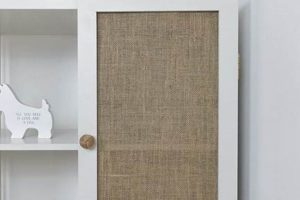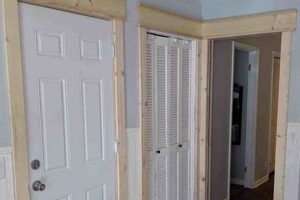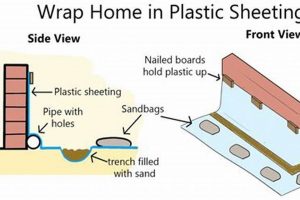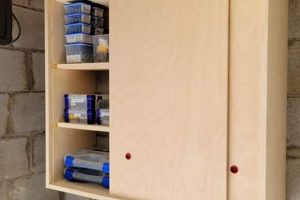The practice of creating cupboard fronts through do-it-yourself methods involves the selection of materials, design, and construction techniques to replace or upgrade existing components. As an example, a homeowner might choose to build new fronts from lumber and hardware purchased from a local retailer, utilizing woodworking skills to achieve a customized aesthetic.
Engaging in this activity offers several advantages, including cost savings, personalized design options, and the satisfaction of completing a home improvement project. Historically, this type of project has been a popular way for individuals to improve the functionality and appearance of their living spaces, reflecting a desire for both practicality and self-expression in the home.
The subsequent discussion will delve into various aspects related to this practice, covering topics such as material selection, essential tools, different construction methods, finishing techniques, and considerations for installation and maintenance.
Guidance for Creating Bespoke Cupboard Fronts
The following recommendations are intended to provide guidance for individuals undertaking the construction of custom cupboard fronts. Adherence to these principles will facilitate a successful project.
Tip 1: Material Selection is Crucial. The choice of lumber directly impacts the final appearance and durability. Hardwoods like maple or oak offer resilience, while softwoods such as pine are more cost-effective but less resistant to wear. Consider the existing cabinetry and the desired aesthetic when making this selection.
Tip 2: Precise Measurements are Imperative. Inaccurate measurements can lead to ill-fitting fronts and significant rework. Measure each opening individually, accounting for reveals and hinge placement. Double-check all figures before cutting materials.
Tip 3: Invest in Quality Hardware. Hinges and pulls are essential components. Opt for durable, well-made hardware that complements the design and provides smooth operation. Consider soft-close hinges to prevent slamming.
Tip 4: Proper Joint Construction is Key. Use appropriate joinery techniques, such as mortise and tenon or rabbet joints, to ensure structural integrity. Glue and clamps are essential for creating strong and lasting bonds.
Tip 5: Sanding is Essential for a Smooth Finish. Thorough sanding is critical for achieving a professional finish. Start with a coarser grit sandpaper and gradually progress to finer grits. Remove all dust before applying finish.
Tip 6: Apply Finish in a Controlled Environment. Dust and debris can compromise the quality of the finish. Work in a well-ventilated area, free from drafts and airborne particles. Apply multiple thin coats for optimal results.
Tip 7: Allow Sufficient Drying Time. Follow the manufacturer’s recommendations for drying times between coats and before installation. Rushing the process can lead to a soft or tacky finish.
These guidelines emphasize the importance of careful planning, precise execution, and attention to detail. Following these recommendations will contribute to a successful and aesthetically pleasing outcome.
The subsequent sections of this document will provide further detailed instructions on specific techniques and best practices related to constructing and installing cupboard fronts.
1. Material Selection
Material selection constitutes a foundational element in the do-it-yourself construction of cupboard fronts. The properties of the chosen material directly influence the final product’s durability, aesthetic appeal, and overall functionality. A judicious choice necessitates a thorough understanding of the various options available and their respective advantages and disadvantages.
- Wood Species and Their Properties
The selection of a specific wood species, such as oak, maple, cherry, or pine, dictates the level of resistance to dents and scratches, as well as the grain pattern and natural color of the front. Hardwoods, like oak and maple, offer increased durability but typically incur higher costs. Softwoods, such as pine, present a more economical option but require greater care to prevent damage. The existing aesthetic of the surrounding environment should guide the decision-making process.
- Engineered Wood Products
Alternatives to solid wood, such as medium-density fiberboard (MDF) and plywood, present options for projects where cost and stability are primary concerns. MDF provides a smooth, uniform surface ideal for painting, while plywood offers increased dimensional stability and resistance to warping compared to solid wood. However, these materials may lack the natural character and longevity of solid wood.
- Hardware Compatibility
The weight and density of the chosen material must be considered in relation to the selected hardware, including hinges and drawer slides. Heavier materials may necessitate stronger hardware to ensure proper operation and prevent premature failure. Incompatibility between materials and hardware can lead to sagging, binding, or complete hardware failure.
- Finishing Considerations
The selected material will influence the range of finishing options available. Some wood species accept stains more readily than others, while engineered wood products may require specialized primers and paints. The desired finish, whether it be a natural wood tone, a painted surface, or a distressed look, should be a primary consideration in the material selection process.
The interplay between material attributes and design objectives is paramount to achieving a successful outcome in cupboard front construction. Careful consideration of these factors ensures that the final product meets both aesthetic and functional requirements, contributing to the overall value and longevity of the cabinetry.
2. Precise Measurements
Accurate dimensional assessment is paramount to the success of cupboard front construction via do-it-yourself methods. Discrepancies in measurements propagate errors throughout the building process, leading to functional and aesthetic deficiencies. Neglecting precision compromises the integrity of the final product.
- Opening Dimensions
The internal dimensions of the cabinet frame represent the primary constraints. Measurements must account for both height and width, considering the potential for variations across multiple openings. Errors in these measurements directly translate to ill-fitting components and necessitate rework, potentially rendering the project unviable.
- Reveal and Overlap Considerations
The intended reveal, or the amount of frame visible around the perimeter of the front, must be factored into the overall dimensions. Consistent reveal measurements ensure a uniform and professional appearance. Inconsistent reveals introduce visual anomalies and diminish the perceived quality of the finished product.
- Hardware Placement and Hinge Mortising
Precise measurements are critical for accurate hinge placement and mortising. Incorrect hinge placement can result in misalignment, binding, or an inability to properly close. Standardized hinge templates and meticulous execution mitigate these risks.
- Material Thickness Adjustments
Variations in material thickness require corresponding adjustments to account for the overall depth and projection of the front. Failure to compensate for these variations can lead to interference with adjacent fronts or the cabinet frame, hindering functionality and creating visual inconsistencies.
The interplay between these measurement-dependent factors underscores the importance of meticulous planning and execution in cupboard front construction. Adherence to precise dimensional standards minimizes the risk of errors, optimizes functionality, and enhances the overall aesthetic appeal of the finished cabinetry.
3. Joinery Techniques
The structural integrity and longevity of cupboard fronts constructed through do-it-yourself methods are directly contingent upon the employed joinery techniques. These methods dictate the strength and stability of the assembled components, influencing the resistance to warping, sagging, and eventual failure. The selection of an appropriate joinery method represents a critical decision point in the construction process, impacting both the aesthetic quality and the functional performance of the finished product. Consider, for example, the application of mortise and tenon joints in framing a solid wood front. This technique provides a robust connection capable of withstanding significant stress, while a simpler butt joint, relying solely on fasteners, is inherently weaker and more susceptible to separation over time. The practical significance of understanding joinery lies in the ability to create durable, visually appealing, and long-lasting cupboard fronts.
Further examples illustrate the importance of selecting appropriate joinery based on the materials used and the intended design. For instance, rabbet joints are frequently employed to attach a panel to a frame, providing a clean and aesthetically pleasing edge. However, the effectiveness of this joint is diminished if the materials are prone to expansion or contraction, potentially leading to gaps or distortion. Miter joints, often used for decorative frames, require precise cutting and alignment to ensure a seamless appearance. Inadequate execution of miter joints results in visible gaps and compromises the overall aesthetic quality. The selection process must consider the inherent strengths and weaknesses of each technique relative to the specific requirements of the project. In the construction of flat panel doors, employing a tongue and groove method to secure the panel within the frame prevents rattling and warping, and enhances the structural stability of the overall front.
In summary, the successful implementation of do-it-yourself cupboard front construction hinges on a comprehensive understanding of joinery principles. While numerous techniques exist, the selection must be guided by the properties of the chosen materials, the intended design, and the desired level of structural integrity. Challenges may arise in mastering complex joinery methods, necessitating practice and precision. However, the resulting improvement in durability and aesthetic quality justifies the investment in acquiring these skills, contributing to the creation of durable and visually pleasing cabinetry.
4. Hardware choices
The selection of hardware constitutes a critical decision point in do-it-yourself cupboard front projects, directly influencing functionality, aesthetics, and longevity. The proper selection and installation of hinges, pulls, knobs, and other fittings is essential for achieving satisfactory results.
- Hinge Selection and Functionality
Hinges dictate the swing and alignment of the cupboard front. Concealed hinges offer a streamlined appearance, while traditional hinges provide a more decorative element. The chosen hinge must be rated to support the weight of the door to prevent sagging or premature failure. Euro-style hinges, for example, allow for adjustments after installation, simplifying alignment. The functional requirements of the installation, such as desired opening angle and overlay type, must be considered.
- Pulls and Knobs: Aesthetics and Ergonomics
Pulls and knobs contribute significantly to the overall aesthetic and user experience. The chosen style should complement the design of the cupboard front and the surrounding cabinetry. Ergonomic considerations, such as size and grip, are also important. For example, larger pulls may be easier to grip for individuals with limited dexterity. Material selection, such as brass, stainless steel, or wood, affects both durability and visual appeal.
- Latches and Catches: Security and Closure
Latches and catches ensure secure closure of the cupboard front. Magnetic catches are suitable for lightweight doors, while roller catches provide a more positive engagement. Child-safety latches offer added security. The selection should be based on the weight of the door, the desired level of security, and the potential for impact or vibration.
- Fasteners and Mounting Hardware: Durability and Stability
The selection of appropriate fasteners and mounting hardware is essential for ensuring the long-term stability of the installation. Screws must be of adequate length and gauge to securely attach the hardware to the door and cabinet frame. Pilot holes are recommended to prevent splitting the wood. The use of high-quality fasteners, such as stainless steel or brass, can prevent corrosion and ensure longevity.
In summary, hardware choices in cupboard front projects encompass a range of functional and aesthetic considerations. Thoughtful selection and proper installation contribute significantly to the overall quality, usability, and longevity of the finished cabinetry. Neglecting this aspect of the project compromises the overall functionality and shortens lifespan.
5. Finishing methods
The successful completion of cupboard fronts via do-it-yourself (DIY) methods hinges significantly on the appropriate application of finishing techniques. These processes serve not only to enhance the aesthetic appeal of the project but also to provide essential protection against environmental factors that can degrade the material over time. The selection of a specific finishing method directly impacts the durability, ease of maintenance, and long-term viability of the constructed fronts. For example, an inadequately sealed wood surface is susceptible to moisture absorption, leading to warping, cracking, and eventual decay. Conversely, a properly applied finish creates a barrier against water, stains, and ultraviolet (UV) radiation, extending the lifespan of the project and preserving its visual characteristics.
Diverse finishing options are available, each possessing unique characteristics and demanding specific application techniques. Paint provides extensive color customization and surface protection. Staining enhances the natural grain patterns of wood while adding a subtle tint. Varnish and polyurethane offer robust, transparent coatings resistant to scratches and chemicals. The choice of finish must align with the intended use, environmental conditions, and desired aesthetic outcome. A kitchen environment, characterized by high humidity and frequent exposure to food splatters, necessitates a more durable and water-resistant finish compared to a display cabinet in a low-traffic area. Preparation is key for any method: sanding to create a uniform surface profile is crucial to ensure a smooth finish, regardless of the product chosen.
In summation, finishing methods constitute an indispensable component of DIY cupboard front construction. The selection of an appropriate finish, coupled with meticulous application, determines the long-term performance and aesthetic appeal of the completed project. The investment of time and resources in understanding and executing proper finishing techniques yields substantial returns in terms of durability, ease of maintenance, and overall satisfaction with the finished product. There can be challenges in selecting the correct finish due to a lack of knowledge. Seek advice before selecting one that is correct for your project to help ensure its aesthetic longevity.
6. Installation procedures
Installation procedures represent the culminating phase of any “cabinet doors diy” endeavor, directly determining the functionality and visual coherence of the completed project. The accuracy and methodical execution of these procedures dictate whether the newly constructed or refurbished fronts operate smoothly, align correctly within the existing cabinetry framework, and contribute positively to the overall aesthetic of the space. Imperfect installation can negate even the most meticulously crafted fronts, resulting in operational impediments, visual disharmony, and potential structural weaknesses. For example, a door installed with misaligned hinges will bind or fail to close properly, while a front secured with inadequate fasteners may detach over time.
The practical application of sound installation techniques encompasses several critical considerations. Precise alignment of the fronts within the frame is paramount, requiring the use of shims and leveling devices to achieve a consistent and visually appealing appearance. Proper hinge placement ensures smooth operation and prevents premature wear on the hardware. Appropriate fastener selection, based on the weight and material of the front, guarantees a secure and lasting connection. Furthermore, attention to detail, such as concealing screw heads and smoothing any rough edges, contributes to a professional and refined finished product. Consider the installation of soft-close hinges, which require specific placement and adjustment for optimal performance; incorrect installation can render the feature ineffective or even damage the hinge mechanism.
In summary, installation procedures are not merely a final step in the “cabinet doors diy” process but an integral component that determines the ultimate success or failure of the project. Accurate execution, attention to detail, and a thorough understanding of hardware requirements are essential for achieving functional, aesthetically pleasing, and durable cupboard fronts. While challenges may arise in aligning complex designs or working with older cabinetry, the benefits of a properly installed front improved functionality, enhanced aesthetics, and increased property value justify the investment in time and effort required to master these procedures.
Frequently Asked Questions
The following section addresses common inquiries regarding the construction of cupboard fronts through do-it-yourself methods. The information presented is intended to provide clarity and guidance to individuals undertaking such projects.
Question 1: What is the typical cost associated with constructing cupboard fronts versus purchasing prefabricated units?
The cost of constructing cupboard fronts can vary significantly depending on the chosen materials, hardware, and complexity of the design. In general, constructing fronts may offer cost savings compared to purchasing prefabricated units, particularly for custom sizes or unique designs. However, this assumes the individual possesses the necessary skills and tools. The cost equation must factor in material costs, hardware expenses, and the value of labor.
Question 2: What are the essential tools required for constructing cupboard fronts?
Essential tools include a table saw or circular saw for accurate cutting, a router for creating edge profiles and joinery, a drill for pilot holes and hardware installation, a sander for surface preparation, measuring tools for precise dimensions, and clamps for securing joints during glue-up. Additional tools, such as a jointer and planer, may be necessary depending on the material and design requirements. A well-equipped workshop is crucial for achieving professional results.
Question 3: What are the common mistakes to avoid when constructing cupboard fronts?
Common mistakes include inaccurate measurements, improper joint construction, inadequate surface preparation, and the use of incompatible hardware. Failing to account for wood movement can lead to warping or cracking. Rushing the finishing process can result in a substandard appearance. Attention to detail and adherence to established woodworking principles are essential for avoiding these pitfalls.
Question 4: How does one ensure consistent reveal gaps between cupboard fronts?
Achieving consistent reveal gaps requires meticulous planning and execution. Precise measurements are crucial, as is the use of spacers or jigs during installation. Careful attention to hinge placement and alignment is also necessary. Uneven cabinet frames may necessitate shimming to achieve a uniform appearance. Patience and precision are key to achieving consistent reveal gaps.
Question 5: What are the considerations for selecting the appropriate wood species for cupboard fronts?
Considerations include durability, grain pattern, color, cost, and workability. Hardwoods, such as oak and maple, offer greater durability but may be more difficult to work with. Softwoods, such as pine, are more affordable but less resistant to dents and scratches. The existing aesthetic of the cabinetry and the desired finish should also inform the decision. A thorough understanding of wood properties is essential for making an informed selection.
Question 6: What are the recommended methods for preventing warping in cupboard fronts?
Preventing warping requires careful material selection, proper construction techniques, and appropriate finishing. Using kiln-dried lumber minimizes moisture content and reduces the likelihood of warping. Employing stable joinery methods, such as mortise and tenon joints, provides structural integrity. Applying a sealant or finish to all surfaces of the front helps to equalize moisture absorption and prevent uneven expansion or contraction.
In conclusion, constructing cupboard fronts requires a combination of skill, knowledge, and attention to detail. Addressing these frequently asked questions can help individuals navigate the process successfully and achieve desirable results.
The subsequent section will explore advanced techniques and design considerations for cupboard front construction.
Cabinet Doors DIY
The preceding exploration has detailed the multifaceted nature of creating cupboard fronts through do-it-yourself methods. From material selection and precise measurements to joinery techniques, hardware choices, finishing methods, and installation procedures, each element contributes critically to the success of the undertaking. A comprehensive understanding of these principles enables the creation of durable, functional, and aesthetically pleasing cabinet components. Mastering this approach, whether for cost efficiency or bespoke design, requires commitment to acquiring technical skills and practical experience.
The viability of “cabinet doors diy” hinges on meticulous planning and unwavering adherence to best practices. While challenges inevitably arise, their successful resolution depends on the rigor applied to the initial design and execution phases. Prospective practitioners should approach this endeavor with a commitment to continuous learning, recognizing that the pursuit of excellence in craftsmanship yields enduring rewards in terms of both personal satisfaction and tangible enhancements to the built environment.







